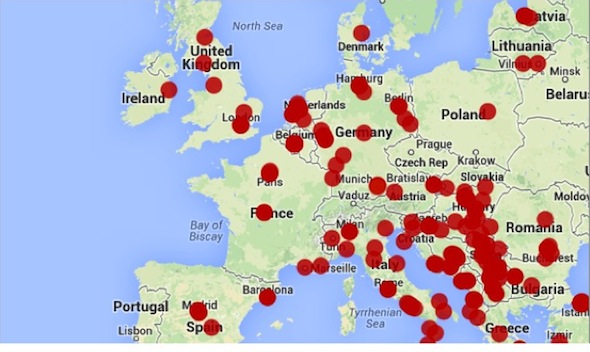
A group of media rights activists have set out to map free expression violations within the European Union to make a visual statement about how it’s increasingly difficult for journalists to do their jobs there.
“There are a lot of violations in the EU. People tend to deny it or deny the seriousness in some cases,” said Melody Patry, who, along with Sean Gallagher, is helping Index on Censorship lead the yearlong project.
From Ireland to Turkey, nearly every country in Europe has at least one red dot on a map visualizing threats to journalists. Police seized reporters’ hardware in the UK; angry Muslims threaten to behead a Kosovar journalist.
In between there is a everything from the seemingly routine–a French reporter blocked by the far right Front National Party from attending a rally–to the cloak and dagger, like denial of service and other cyber-attacks in Turkey.
And then there was the Serbian editor who was beaten–twice–with a baseball bat.
Index, headquartered in the UK, and Osservatorio Balcani e Caucaso (Balkans and Caucasus Observatory), based in Italy, want to quantify the prevalence and seriousness of free expression violations. Funded by a grant from the EU, the pilot project employs eight journalists who monitor sections within the block. Regional groups like the South East Europe Media Organization support their efforts.
No country can join the EU without guaranteeing freedom of expression as a basic human right in their national laws. Additionally, the EU charter promises free speech. While there was the feeling among rights activists that the freedom was eroding, no one knew for sure.
“We didn’t know what the universe was with censorship in Europe. That’s kind of odd,” Gallagher said. “We knew anecdotally from our work, but there was nothing really out there that was trying to quantify it.”
Using open source software, the group has been able to show that journalists are being hampered from doing their work across the continent. Serbia has the most recorded offenses, 33, but Gallagher said that is more likely because the journalists’ union there is vocal about reporting incidents and that the Balkans and Caucasus Observatory has close ties to the country. Turkey, with 27 reports, and Hungary, with 24, are close behind. The map currently shows 276 verified cases in all but three* of the EU’s 28 member states and nine candidate countries, and more reports are in the process of being verified.
Though monitors attempt to verify all reports by interviewing the parties involved where possible, problems with the data remain. They know there are more incidents than are being reported, and monitors don’t always use the same definitions to classify data. Glitches mean some reports still aren’t visible on the map. And alleged money problems at the Index don’t allow the group to tailor the open-source software specifically to the project’s needs.
Still, the data is available for anyone to use and already is being analyzed by academics in Hungary and Ireland.
Six months in, Patry says she can see patterns developing: Southern European journalists are reporting more physical violations and threats. Perhaps because of that, most journalists self-censor, fearing they will lose their job or face financial or physical consequences. Meanwhile, Western reporters appear to have more diverse problems. Reporters and cartoonists ran into headaches when attempting to mock the monarchy (Spain); photographers couldn’t photograph a princess playing hockey (The Netherlands). A public broadcaster in Ireland censored a comic sketch on religious grounds. In Italy, a newspaper was closed to prevent it from reporting on an investigation into alleged corrupt practices by local politicians. In Denmark, two journalists were convicted for revealing the names of 12 pig farms that are the source of a staph virus dangerous to humans.
In Eastern Germany, a small but feisty local paper has been vandalized twice for reporting on the rise of neo-Nazi groups. And post after post record layoffs and closings of media outlets, which NGO staffers argue could be problematic in keeping government, especially local ones, in check.
The mapping highlights new problems, too, like cyberbullying, hacking, and denial of service. Turkish journalists seem to report the most instances of cyber attacks. Project monitors offer to direct assistance to journalists from groups that can help secure their laptops and mobile devices from online snoopers to getting police protection to legal advice. Most, however, don’t seem to take them up on the offer, Patry said.
In the end, Patry and Gallagher hope that human rights activists can leverage the data to press for adherence to existing EU laws.
Although the money for the pilot project runs out next spring, Gallagher said he is hoping to continue mapping expression issues. Index on Censorship, founded in 1972 to give voice to dissidents behind the Iron Curtain, supported and published the works in their magazine of banned writers across the world. These included Czech playwright and future president Vaclav Havel and post-fatwa Salman Rushdie. So it’s in keeping with their mission to fight censorship of all kinds.
Next month, they are starting to map censorship issues of all kinds in India, Tunisia, and Senegal, but they want to make it a worldwide effort.
“If anything, this (project) has shown that censorship is everywhere,” Gallagher said.
*Corrects the number of countries without an incident on the map
Alison Langley 's stories have appeared in a variety of publications, including The New York Times, The Guardian, The Financial Times, and Deutsche Welle. She currently lives in Zurich.
